This is our review of the best water filter for lead in 2022.
Lead in your water supply can affect the health and wellness of your whole family. Unlike other minerals and some contaminants, lead cannot be detected with the human eye or by smell.
If you live in a home that was built before 1986, you are more likely to have lead in your water supply.
Installing a water filter for lead can reduce and even eliminate your exposure to lead, but finding the right filter can be a challenge and take all day or more.
After evaluating numerous lead systems, we determined the best water filter for lead removal to be the Springwell Whole house system which has capacity to remove 99.5% of lead in water. Clearly Filtered pitcher and AquaTru Countertop RO systems are also good brands to consider.
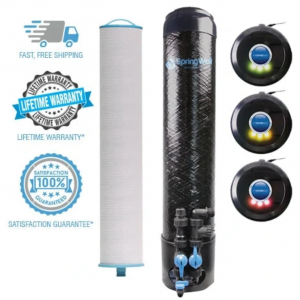
- System Type: Whole house
- Dimensions (inches): 8 x 40
- Flow Rate: 8 GPM
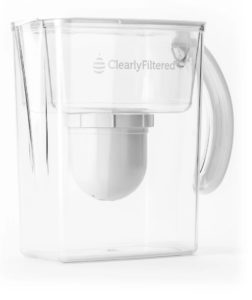
- System Type: Water Pitcher
- Dimensions (inches): 11.2 x 5.1 x 10.2
- Capacity: 10 Cups
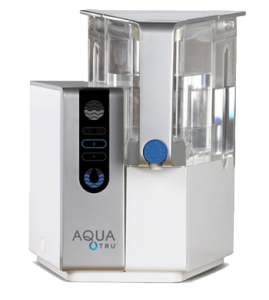
- System Type: Countertop Reverse Osmosis
- Dimensions (inches): 14 x 14 x 12
- Filter Stages: 4
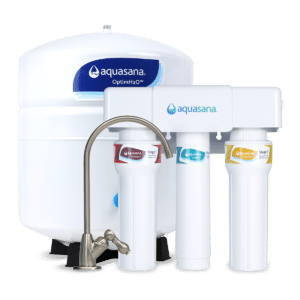
- System Type: Undersink
- Dimensions (inches): 16″ x 11″
- Flow Rate: 35 gpd
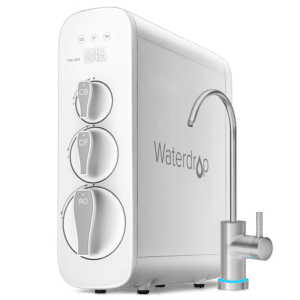
- System Type: Reverse Osmosis
- Dimensions (inches): 18.1 x 5.7 x 17.8
- Filter Stages: 7
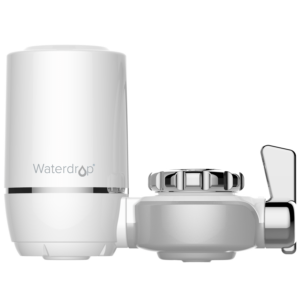
- System Type: Faucet
- Dimensions (inches): 8.1 x 7.1 x 2.9
- Filter Capacity: 3 Months
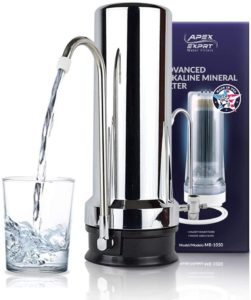
- System Type: Countertop
- Dimensions (inches): 12 x 4.5 x 4.5
- Filter Stages: 5
Best Water Filter For Lead Removal
1. SpringWell Whole House Lead Removal System

High acidity or low mineral content can corrode pipes and fixtures, causing lead to enter your drinking water. This can potentially be a huge problem because there is no safe level of lead for the human body.
The SpringWell Whole House Lead & Cyst Removal System solves this problem by removing 99.95% of heavy metals from your water, while also removing and treating cysts, chlorine, chloramine, and other harmful contaminants.
The 0.5-micron nominal filtration level removes 99.95% of particulate and soluble lead from your drinking water. The system’s binders chemically react with soluble lead, creating an ionic bond that kinetically removes the lead from the water.
This system has been tested and certified as required in the NSF/ANSI P473 standard for PFOA/PFOS, along with NSF/ANSI 53 standard for the reduction of lead and cyst. In addition to lead, the SpringWell removes chlorine, chloramine, giardia, and crypto, so you can rest assured that your water is as pure as it can get.
This system also features a real-time dynamic LED system that monitors water and flow rate through color-coded notifications. SpringWell’s Lead & Cyst Removal System includes a 100,000 gallon capacity with the highest water pressure. While the installation kit provides all you need to install this system, you may need to hire a professional if you don’t have plumbing knowledge.
Lead removal is a serious process, and the SpringWell Whole House Lead & Cyst Removal System guarantees optimal, reliable, and durable performance. With over 20 years of experience in water quality and the belief that every family deserves pure drinking water, SpringWell is a company to be trusted.
Read our full review: SpringWell Whole House Lead & Cyst Removal System
- Removes 99.5% lead from water, along with other harmful chemicals
- Innovate digital notification head that provides color-coded monitors
- Installation kit includes all you need to install this system
- 100,000 gallons capacity
- Leak-proof
- Manufacturer’s lifetime guarantee and six-month money-back guarantee
- You may need to hire a plumber to install this system.
- Does not include a replacement filter.
2. Clearly Filtered Water Pitcher For Lead

Specifications:
- 100-gallon filter life
- 80 oz (10 cups) capacity
- 11.2” x 5.1” x 10.2”
- 2.3 lbs
The Clearly Filtered Water Pitcher will remove more contaminants from your water than the top three leading brands combined. Not only does it target lead, but also fluoride, BPA, glyphosate, and PFOAs. It even removed hormone and pesticide runoff.
Water is filtered in three stages to remove as many impurities as possible. The first stage passes water through a stainless steel mesh screen to remove large particles. Next, a granulated coconut carbon filtration layer removes chlorine and other bad tasting components.
During the final stage, water flows through a dense composite shell containing more than seven different filtration materials. In the pitcher, you’re left with crisp, crystal-clear water containing all of the nutrients you need without the impurities.
Clearly Filtered Pitcher is currently the only pitcher to meet NSF standards 42, 53, 244, 401 & 473. Everything is made of 100% BPA-free, medical-grade Tritan materials to ensure there’s no risk of chemicals seeping into your drinking water.
This pitcher boasts a comfortable, ergonomic handle for easy pouring. It’s large enough for most grips and won’t slip out of your palm during use. The clear reservoir includes a built-in water dam to keep untreated water separated during filtering.
Related: Best Water Filter Pitcher Reviews
- Removes hundreds of common contaminants
- Three-stage filtration for up to 99.7% removal rate
- 100% BPA-free
- Surpasses strict NSF safety standards
- Attractive and ergonomic design
- Pricier than other filter pitcher options
- Loose-fitting lid
3. AquaTru Countertop RO For Lead

Specifications:
- 600 to 1200 gallon filter life
- One-gallon capacity
- 14” x 14” x 12”
- 22.6 lbs
The AquaTru Countertop RO uses a series of four separate filtration processes to remove as many as 82 common contaminants from your water, removing lead as well as arsenic, radium, nitrates, and more.
A mesh pre-filter removes the largest particles from the water, including dirt, dust, and even rust from pipes. After passing through the pre-filter, water then travels through an activated charcoal carbon filter to remove chlorine, bad tastes, and foul odors.
Water reaches the semi-permeable reverse osmosis filter during the third stage of the filtration process. It’s here that the most contaminants are removed, including chemicals, pharmaceuticals, and even dangerous microorganisms and germs.
During the final stage of filtration, water passes through a coconut shell, activated carbon filter. This strips away any remaining contaminants that the RO filter may have missed, ensuring that water comes out pure and delicious.
The AquaTru boasts a sleek, compact design that will fit on just about any kitchen countertop. It’s easy to install without adding extra wires or plumbing, making it a great choice for renters. You can set up the filtration system in just minutes, and you won’t need to hire any professional help.
This RO filter is as easy to maintain as it is to install. You can replace the quick-change filters as needed by simply twisting them into place. An easy-to-read digital display lets you know when it’s time to replace your filters so that you don’t have to worry about marking it in your calendar.
The plastic body is free of BPA and BPS components that might leach into your drinking water. Everything is made of safe and durable Tritan plastic to ensure quality and longevity. The AquaTru surpasses current NSF standards.
Related: Best Countertop Reverse Osmosis System / Water Filter
- Removes up to 82 common contaminants
- Compact enough to fit most kitchens
- Easy to install and maintain
- BPA and BPS-free
- Tested and certified according NSF standards
- Smaller capacity than under sink RO options
- Prone to leaking
4. Aquasana OptimH20 Under sink System For Lead

Specifications:
- 0.5 gallons per minute flow rate
- 6 month to 1-year filter life
- 30” x 50” x 12.5”
- 12.3 lbs
The Aquasana OptmH20 uses four different filtration techniques to remove more than five times more impurities than other RO systems and fifteen times more than the leading filter pitcher.
Claryum technology combines reverse osmosis ion exchange with sub-micron mechanical filtration along with activated and catalytic carbon filters. The entire filtration process removes dozens of contaminants, including lead, arsenic, fluoride, nitrates, radium, bacteria, pesticides, and more.
Not all minerals found in drinking water are necessarily undesirable. To maintain taste and quality, the Aquasana OptimH20 boasts a remineralization process that reintroduces healthy nutrients back into your drinking water. Adding minerals such as calcium, potassium, and magnesium balances pH and improves the taste of drinking water.
This filtrations system comes with a stylish, all-metal faucet in three different finishes to match any kitchen design. You can find the faucet in a choice of brushed nickel, chrome, or oil-rubbed bronze, all offering a 44% faster flow rate than the average tap.
The Aquasana OptimH20 is an eco-friendly choice for those looking to lower their carbon footprint. The design uses minimal amounts of plastic and has few disposable parts to reduce waste. It can also help households to reduce their reliance on disposable plastic bottles.
This water filtrations system comes NSF tested and certified, It meets standards 42, 53, 58, and 401, making it a safe and effective choice for just about any household.
Related: Best Rated Under Sink Water Filters That Fit Under the Counter
- Combines four types of filtration to remove 99% of contaminants
- Remineralization maintains water taste and quality
- Comes with a stylish metal tap
- Eco-friendly, low-waste choice
- Meets NSF testing standards
- Might be too large for small kitchen setups
- Connectors are prone to leaking
5. WaterDrop Reverse Osmosis System For Lead

Specifications:
- 0.28 gallons per minute flow rate
- 18.06” x 5.68” x 17.76”
- 31 Pounds
The WaterDrop Reverse Osmosis System uses a cross-filtration method that includes seven different treatment stages to remove lead and other heavy metals as well as limescale, viruses and bacteria, and more.
A carbon block CF filter, a 3-layer DOW RO membrane, and a post-activated carbon block remove the bulk of both large and microscopic contaminants from your water. The carbon block filter is made of coconut shell to remove unwanted tastes and odors for crisp, delicious drinking water.
The WaterDrop RO System monitors your water to ensure safety and quality at all times. A smart TDS monitoring panel measures the amount of total dissolved solids to alert you when there are high levels of contaminants present.
An easy-to-read light system tells you the status of your water filter at a glance. When the RO filter is working optimally, the light shines blue. When it switches to yellow, however, you need to consider replacing your filter. A red alert light signals the need for an immediate replacement.
The WaterDrop RO system includes a food-grade, copper-zinc alloy faucet to allow for even water flow. The faucet comes in brushed nickel to give it a sleek, elegant touch that’s sure to look good in any kitchen setup. All materials are NSF 58 & 372 certified.
Related: The Best Reverse Osmosis Systems – Which RO Water Filter Is Right For You?
- Seven-step filtration process
- Automatically monitors TDS levels
- A convenient light alert system
- Meets necessary NSF standards
- Includes food-grade faucet
- Low water pressure
- Light alert system prone to failure
6. WaterDrop Faucet Filter For Lead

Specifications:
- 320 gallon or 3-month filter life
- 0.5 gallons per minute flow rate
- 8.06” x 7.1” x 2.9”
- 1 lb
The WaterDrop Faucet Filter fits most standard tap styles with a convenient tap adapter for easy installation. It boasts a steady, 0.5 GPM flow rate to ensure that you don’t have to wait to fill your glass. In just a single minute, the WaterDrop outputs enough clean water to fill 10 7 oz cups.
The system treats water using an activated carbon block, or ACF. It has a generous surface area with plenty of microscopic holes and divots to catch impurities. The carbon also attracts potentially harmful compounds such as chlorine, lead, and other heavy metals, removing them from the water before you drink it.
An easy-access switch allows you to switch effortlessly between treated and untreated water to preserve each filter’s lifespan. You can use filtered water for drinking and cooking while saving unfiltered water for cleaning and dishes, all without ever removing your faucet filter. Filters can last twice as long as other faucet filtration systems.
The WaterDrop Faucet Filter meets NSF standard 42 and 372, making it a safe choice for most households. It’s been tested and certified to ensure quality and efficacy.
Related: The 6 Best Faucet Water Filter For Every Kitchen
- Fits most standard faucets
- ACF improves taste and clarity
- Fast, even flow rate
- Easily switch between filtered and unfiltered water
- Meets basic NSF standards
- Removes fewer contaminants than other filtration options
- Prone to leaking with high water pressure
7. APEX Countertop Filter For Lead

Specifications
- 85 pounds
- 12 x 4.5 x 4.5 inches
- Filters up to 750 gallons of water
The APEX Countertop Filter is one of the most convenient filters on the market. There’s no need to fill a pitcher or change out filters regularly. The filter will effectively remove 99 percent of substances found in tap water, such as chlorine, sodium, and lead, for up to 750 gallons.
The alkaline water filter adds calcium, magnesium, and potassium to your water, which is known to balance pH levels in the blood, help detoxify the body, and improve health overall.
APEX follows the guidelines on drinking water from the Nation Safety Foundation (NSF) and the FDA. APEX also offers a 30-day-money back guarantee with a limited one-year warranty.
The filters are easy to replace, and the filter is easy to install if you have a standard faucet. The Apex water filter comes with a housing wrench, instruction manual, diverter valve, and two faucet adapters.
Related: Best Countertop Water Filter For The Money
- Filters out lead and other contaminants
- Improves pH levels in the drinking water
- Eliminates the need for bottled water
- Saves money
- Easy to use and install, including good email support
- Only works with standard faucets
- May be difficult to change the filter
- Need to keep out of direct sunlight to prevent algae growth
We’re confident that at least one of our top recommendations will remove lead from your water. Let’s take some time to discuss some things to consider before you purchase a water filter for lead and why it’s important to filter lead out of your water supply.
Pre-Purchase Considerations
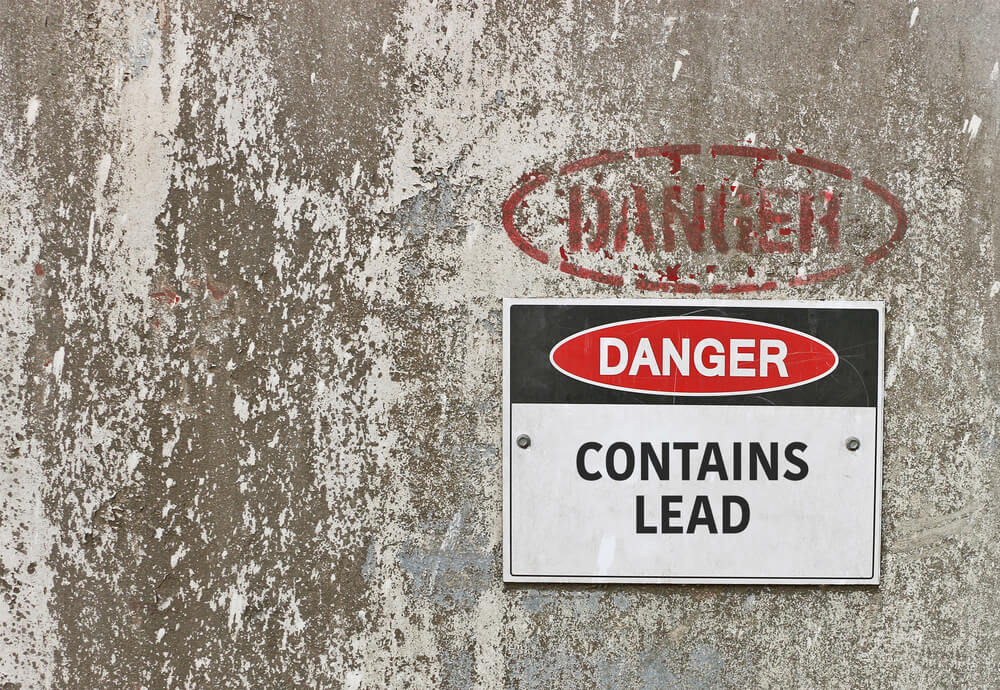
Unlike other minerals, like iron, lead is virtually impossible to detect in your water and filtering your water can keep you and your family healthy.
While we’ve done the research and reviewed six great water filtration options for removing lead, there are still some things you should think about before you buy a water filter for lead.
1. Type of Filter
Removing lead from your drinking water is important, but the type of filter for lead that you choose may depend on the space you have in your home. If you have a small kitchen or limited counter or cabinet space, a filtered water pitcher faucet filter may be your best option.
Depending on how much water you drink or use can also help you determine which type of lead filtration system is best for your home. If you have other contaminants that you worry about, other than lead, such as iron, you may prefer a whole house filter system or one that uses reverse osmosis. It’s also a good idea to check for industry certification like that from NSF and choose the right model for your needs.
2. Replacing Your Filters
How frequently you need to replace your filters will greatly depend on how often you use filtered water. If you are trying to find a more cost-effective filtration system, the cost of a filter pitcher (and replacement filters) may end up being roughly the same as a countertop or faucet filter.
Before you buy a water filter for lead, you want to make sure that replacement filters are readily available to ensure that your drinking water remains free of lead. Also pay attention to the day interval between replacement to account for your effort and expense.
3. Installation: DIY or Professional?
A filter pitcher is the easiest filtration system to install, but if you want a whole house system or one that fits under your sink, you need to decide if you want to install the system yourself or hire a pro.
All of the systems that we recommend are designed to be installed by homeowners with minimal effort and most hardware or tools are included. Many of the manufacturers also offer good email support.
Ultimately, it will depend how much of your day is available to install a system and if it’s better to just have the convenience of having it installed by a pro.
4. Test Your Water
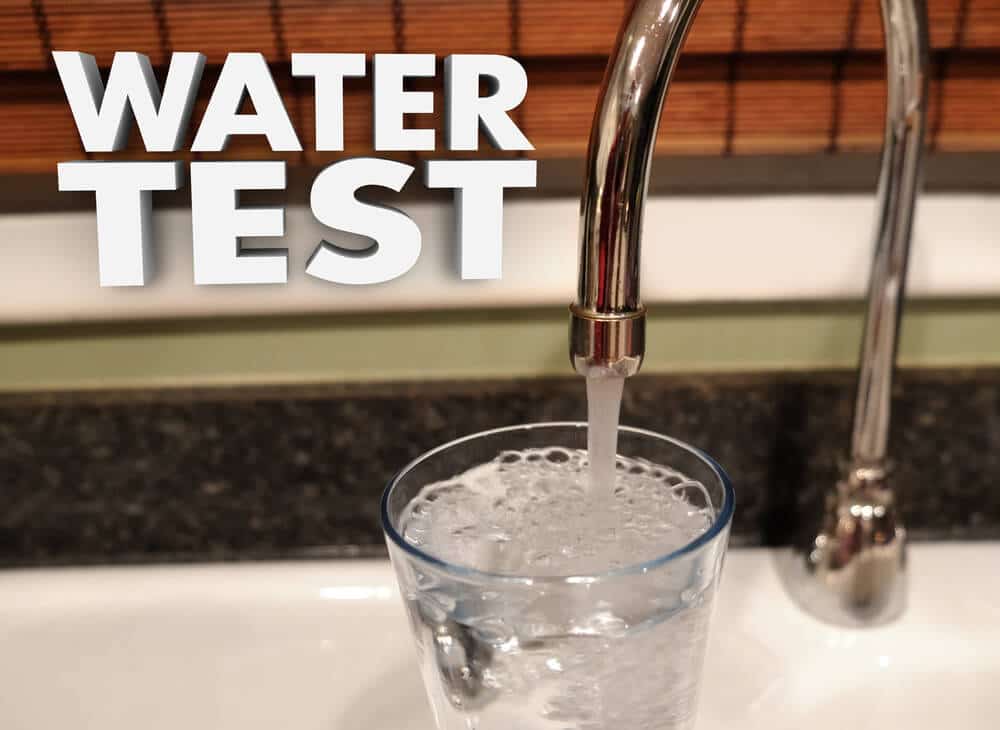
Removing all traces of lead from your drinking water is beneficial to you and your family. Before you purchase a filter for your drinking water, it’s always a good idea to test your water.
If your lead levels are higher than recommended you filtering your water may not be enough to keep you safe, but most filtration systems are effective for low levels of lead.
How Does Lead Affect the Human Body?
While drinking water may not be the main source of lead poisoning, approximately 20 percent or more of lead exposure comes from drinking water. Infants who drink formula may be more at risk if their water supply contains lead.
Lead has many ways of entering our body, which includes contaminated air, soil, paint, dust, and in the water we drink. Everyone who consumes water with lead is at risk of health issues, but infants, young children, and pregnant women are most at risk for serious health problems which may even be fatal.
Since lead is difficult to detect, lead poisoning can be nearly impossible to recognize until health problems become more severe. Signs and symptoms to watch for, which may indicate lead poisoning, include (but are not limited to) developmental delay, seizures, weight loss, hearing loss, and extreme fatigue in children.
Infants may be exposed to lead before birth or shortly after and can result in issues like premature birth, low birth weight, and stunted growth. Pregnant women, who have lead in their body, may miscarriage or experience stillbirth.
Lead poisoning in adults can result in high blood pressure, joint and muscle pain, headaches, abdominal pain, reproductive issues, and mood disorders. Since the symptoms of lead poisoning may be similar to other physical or mental health issues, it’s important to have your water tested and have your blood tested for lead.
The best way to avoid lead exposure through drinking water is to drink filtered water and only to consume cold water from the tap. Hot water typically contains higher levels of lead and boiling will not remove lead from water. It is safe to bath in water which contains lead, as it doesn’t absorb into the skin, but you should always use caution to make sure babies and children don’t drink unfiltered water while bathing.
If you want to eliminate as much lead from your water as possible, particularly when doing dishes or bathing, you may benefit from a whole house water filtration system rather than one that fits beneath the sink and only filters one water source.
How Does Lead Get into Water?
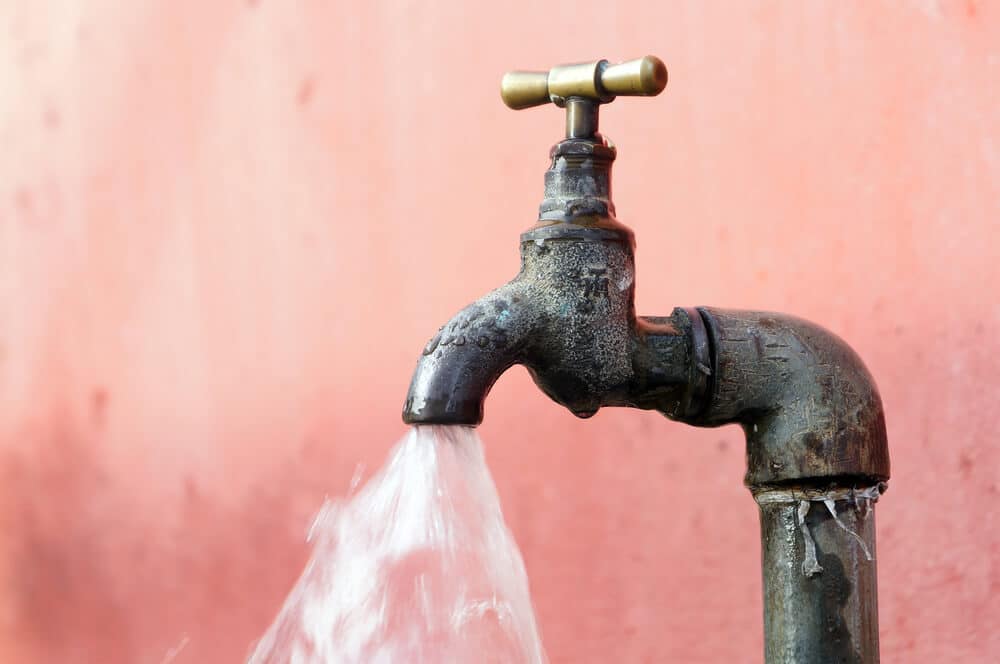
Although the amount of lead in drinking water has greatly reduced in the last two or three decades, (thanks to the Safe Drinking Water Act and EPA’s Lead and Copper Rule) issues with lead contamination are still prevalent.
While most water sources are not severely contaminated with lead, as we see in Flint, Michigan, some water sources may have more lead than what is considered to be safe.
If your home was built before 1986, when the Safe Drinking Act was enacted, you may have larger amounts of lead in your water supply. Lead in your water can come from metal water taps, the pipes inside your home, and the pipes that connect your house to the main water supply in the street.
The water becomes contaminated when the older pipes become corroded or the solder, which connects the pipes, begins to corrode. Even when water sits in lead pipes for a short period, it can affect your water supply.
According to the EPA, the amount of lead in your water not only depends on the age and condition of your pipes, but also how long the water stays in the pipes, and the temperature or acidity in the water.
How To Remove Lead From Water
Updating the pipes in and to/from your home can reduce the lead in your water, but for many people that is an expensive solution. Filtering the lead from your drinking water is the most effective way to remove lead from your water, particularly if you use filters that are designed for lead removal.
You can also reduce the amount of lead in your water by cleaning the aerator (faucet screen) and flushing your pipes before using or consuming water.
Lead Frequently Asked Questions
In this comprehensive guide, we want to provide you with as much information as possible about water filters for lead removal and the effects of lead. Feel free to email us if you have a question we didn’t already answer.
Unlike iron and other chemicals like chlorine, lead has no taste, so many people who have lead in their water supply are unaware until they have their water tested.
The best way to find out if lead is in your water is to have it tested and filtering your water will reduce your exposure. A blood test can tell you if you have any lead in your body.
Lead doesn’t discolor water or cause staining in your appliances or fixtures. Lead is not seen by the human eye and it doesn’t have an odor either.
Lead can cause developmental delays in small children and results in numerous other health problems in individuals of all ages.
Lead affects major organs, which include the brain. Some research suggests that lead exposure from water may contribute to dementia later in life, but since dementia is still somewhat of a medical mystery, there are many factors that can contribute to memory loss.
There’s no definite answer that lead exposure is directly related to dementia, but it may play a role.
High-quality water filters are designed to filter out the contaminants, like lead, that can make you sick, but if you fail to clean or replace your filtration system, you may start to feel sick. Expired filters will not effectively filter out contaminants and depending on what you are filtering out; you may start to fill the negative effects.
Water pitchers and other filtration systems are sensitive to light and should stay out of direct light to avoid mold or algae from growing. Cleaning your filtration system (such as a pitcher) and replacing your filters regularly can keep you from having headaches or digestive issues.
There are a number of water filters that remove lead (we reviewed six great options), but it’s important to note that not all water filters will remove lead as effectively as others. Most carbon filters will remove lead from your water, but it’s important to read the packaging.
Don’t buy a filter unless it says that it filters lead. If the filter claims to remove contaminants, you should not assume that lead is included.
More Contaminants Filter:

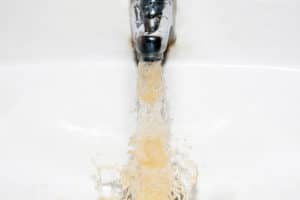
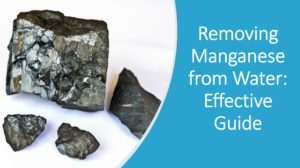

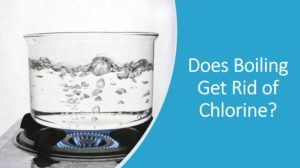
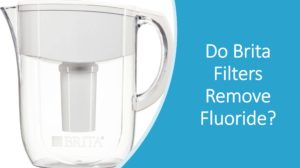
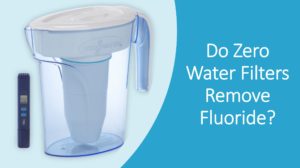

no.3 is easy to installed, no strange odors or cloudy water left, the water quality is very improved. I am satisfied with this device.
Thanks for the feedback, Glen, I’m glad it worked out well for you!
My problem is I cannot replace lead pipes from St Paul city water pipes, so I am investigating a lead removal filtration system